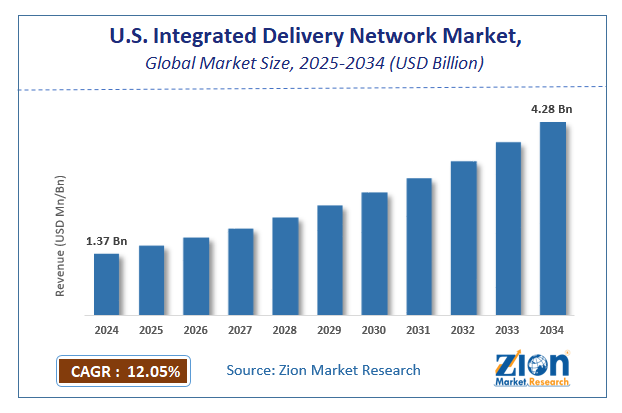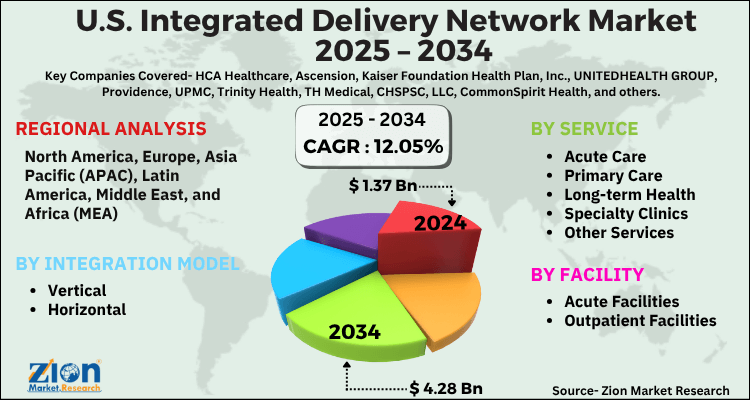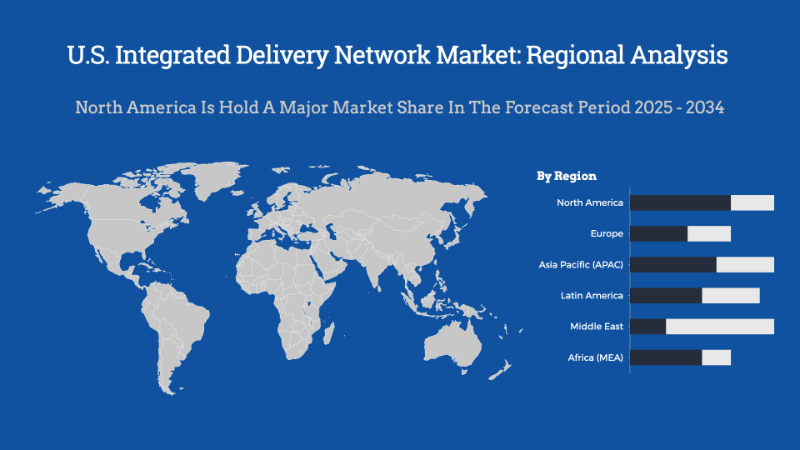U.S. Integrated Delivery Network Market Size, Share, Growth Analysis Report - Forecast 2034

U.S. Integrated Delivery Network Market By Integration Model (Vertical, Horizontal), By Service (Acute Care, Primary Care, Long-term Health, Specialty Clinics, Other Services), By Facility (Acute Facilities, Outpatient Facilities), and By Region: Global and Regional Industry Overview, Market Intelligence, Comprehensive Analysis, Historical Data, and Forecasts 2025 - 2034
| Market Size in 2024 | Market Forecast in 2034 | CAGR (in %) | Base Year |
|---|---|---|---|
| USD 1.37 Billion | USD 4.28 Billion | 12.05% | 2024 |
U.S. Integrated Delivery Network Market: Industry Perspective
The global U.S. integrated delivery network market size was worth around USD 1.37 Billion in 2024 and is predicted to grow to around USD 4.28 Billion by 2034 with a compound annual growth rate (CAGR) of roughly 12.05% between 2025 and 2034. The report analyzes the global U.S. integrated delivery network market's drivers, restraints/challenges, and the effect they have on the demands during the projection period. In addition, the report explores emerging opportunities in the U.S. integrated delivery network industry.
The report analyzes the U.S. integrated delivery network market drivers, restraints/challenges, and the effect they have on the demands during the projection period. In addition, the report explores emerging opportunities in the U.S. integrated delivery network industry.
U.S. Integrated Delivery Market: Overview
In the United States region, an integrated delivery network (IDN) refers to the existence of a collaborative network consisting of healthcare facilities, organizations, and healthcare professionals or providers that work in coherence to deliver effective, coordinated, comprehensive healthcare services to people who require medical care. The system typically includes hospitals, clinics, physician practices, home healthcare agencies, long-term care facilities, and other healthcare entities. The end goal of an IDN system is to ensure that the patients of that region have access to an integrated healthcare system. The stakeholders consistently work toward enhancing the process across providers and settings. It also aims to improve the quality of medical care, patient outcome, and efficiency. The organization and structure of IDN may vary between states and regions but the main goal remains the same throughout.
U.S. Integrated Delivery Market: Growth Drivers
Rising demand for value-based care to propel market growth
The U.S. integrated delivery network market is projected to grow owing to the increasing demand for value-based care across the regional states. As patients' awareness rate is rising, there has been a significant shift from the fee-for-service model of the US healthcare infrastructure to value-based care which has assisted in improved investment in IDN architecture of the country.
Such a model focuses on reducing the financial burden of medical care on the patients while also improving patient outcomes. This can be achieved by emphasizing preventive care, care coordination, and population health management.
Over the years, the U.S IDN systems have managed to position themselves allowing them to play a key role in rolling out and implementing such initiatives with providers and payers. The shifting model to ambulatory care also aligns with the industry growth trend.
Restraints:
High fragmentation to restrict market expansion
The regional market of IDN is expected to witness restricted growth due to the high fragmentation of the U.S. healthcare system. It involves various stakeholders including hospitals, physicians, payers, and post-acute care providers. All of these responsible parties operate independently and there is a significant lack of effective coordination for the IDN system to reach its true potential. This high fragmentation index can significantly disrupt the seamless integration and coordination of care within IDNs since every unit may have different reimbursement structures, priorities, and information systems.
Opportunities:
Growing incidences of chronic diseases to provide several growth opportunities
The U.S. is registering a surge in patients with chronic conditions such as diabetes, cardiovascular conditions, and respiratory disorders. This trend has resulted in the regional healthcare sector facing several challenges.
IDNs are expected to benefit from the range of growth opportunities thus arising by implementing remote monitoring technologies, evidence-based care protocols, and patient education programs. By focusing on preventive strategies and proactive management, IDNs will be in a position to improve outcomes, reduce hospitalizations, and lower healthcare costs.
Challenges:
Concerns over cost-efficiency and return on investment to challenge market growth
The U.S. integrated delivery market is projected to come across challenges owing to the growing concerns over cost-efficiency and return on investment (ROI). The establishment of an IDN and operating it effectively required significant investment. Multiple financial resources are required to set up a functional integrated care model which implements advanced technology systems.
Furthermore, the return on investment for the development of care coordination infrastructure should be justified. These factors are likely to impede the regional market growth.
Key Insights
- As per the analysis shared by our research analyst, the global U.S. integrated delivery network market is estimated to grow annually at a CAGR of around 12.05% over the forecast period (2025-2034).
- Regarding revenue, the global U.S. integrated delivery network market size was valued at around USD 1.37 Billion in 2024 and is projected to reach USD 4.28 Billion by 2034.
- The U.S. integrated delivery network market is projected to grow at a significant rate due to rising demand for cost-effective healthcare, value-based care models, and consolidation of hospitals and providers for streamlined services.
- Based on Integration Model, the Vertical segment is expected to lead the global market.
- On the basis of Service, the Acute Care segment is growing at a high rate and will continue to dominate the global market.
- Based on the Facility, the Acute Facilities segment is projected to swipe the largest market share.
- Based on region, North America is predicted to dominate the global market during the forecast period.
U.S. Integrated Delivery Network Market: Report Scope
| Report Attributes | Report Details |
|---|---|
| Report Name | U.S. Integrated Delivery Network Market |
| Market Size in 2024 | USD 1.37 Billion |
| Market Forecast in 2034 | USD 4.28 Billion |
| Growth Rate | CAGR of 12.05% |
| Number of Pages | 220 |
| Key Companies Covered | HCA Healthcare, Ascension, Kaiser Foundation Health Plan, Inc., UNITEDHEALTH GROUP, Providence, UPMC, Trinity Health, TH Medical, CHSPSC, LLC, CommonSpirit Health, and others. |
| Segments Covered | By Integration Model, By Service, By Facility, and By Region |
| Regions Covered | North America, Europe, Asia Pacific (APAC), Latin America, The Middle East and Africa (MEA) |
| Base Year | 2024 |
| Historical Year | 2020 to 2023 |
| Forecast Year | 2025 - 2034 |
| Customization Scope | Avail customized purchase options to meet your exact research needs. Request For Customization |
U.S. Integrated Delivery Network Market: Segmentation Analysis
The global U.S. integrated delivery network market is segmented based on Integration Model, Service, Facility, and region. All the segments have been analyzed based on present and future trends and the market is estimated from 2025 to 2034.
Based on Integration Model, the global U.S. integrated delivery network market is divided into Vertical, Horizontal.
On the basis of Service, the global U.S. integrated delivery network market is bifurcated into Acute Care, Primary Care, Long-term Health, Specialty Clinics, Other Services.
By Facility, the global U.S. integrated delivery network market is split into Acute Facilities, Outpatient Facilities.
The Regional, this segment includes the current and forecast demand for North America, Europe, Asia Pacific, Latin America,and the Middle East and Africa.
Recent Developments:
- In December 2024, Mckinsey & Company reported that there were several recent trends that pointed toward growing demand for value-based care. The report also claimed that the value-based care market could soon become a USD 1 trillion enterprise. It is emerging as a distinct landscape in the healthcare sector. As per the report, investments toward value-based care quadrupled during the pandemic
- In October 2024, symplr reported that healthcare organizations with different missions and visions are collaborating in the backdrop of surging costs and a rising shift toward value-based care. The entities are joining forces to promote the IDN structure, also known as ‘payviders’. The main goal of the facilities is to improve healthcare safety, quality, and patient outcome
U.S. Integrated Delivery Market: Regional Analysis
The U.S. integrated delivery market exhibits notable regional variations driven by differences in healthcare infrastructure, population demographics, and regulatory environments. Regions like the Northeast and West Coast, with dense urban populations and advanced healthcare systems, show strong adoption of integrated delivery networks (IDNs) focused on coordinated care and value-based models. The Midwest and South are also experiencing growth, spurred by hospital consolidations and efforts to enhance care efficiency across sprawling rural and suburban areas. Factors such as rising chronic disease prevalence, demand for cost-effective care, and digital health adoption continue to shape regional dynamics, with IDNs increasingly investing in technology integration and patient engagement strategies to optimize service delivery across diverse U.S. markets.
U.S. Integrated Delivery Network Market: Competitive Analysis
The report provides a company market share analysis to give a broader overview of the key market players. In addition, the report also covers key strategic developments of the market, including acquisitions & mergers, new product launches, agreements, partnerships, collaborations & joint ventures, research & development, and regional expansion of major participants involved in the U.S. integrated delivery network market on a global and regional basis.
The global U.S. integrated delivery network market is dominated by players like:
- HCA Healthcare
- Ascension
- Kaiser Foundation Health Plan Inc.
- UNITEDHEALTH GROUP
- Providence
- UPMC
- Trinity Health
- TH Medical
- CHSPSC LLC.
- CommonSpirit Health
U.S. Integrated Delivery Network Market: Segmentation Analysis
The global U.S. integrated delivery network market is segmented as follows;
By Integration Model
- Vertical
- Horizontal
By Service
- Acute Care
- Primary Care
- Long-term Health
- Specialty Clinics
- Other Services
By Facility
- Acute Facilities
- Outpatient Facilities
U.S. Integrated Delivery Network Market: Regional Segment Analysis
- North America
- The U.S.
- Canada
- Mexico
- Europe
- France
- The UK
- Spain
- Germany
- Italy
- Rest of Europe
- Asia Pacific
- China
- Japan
- India
- Australia
- South Korea
- Rest of Asia Pacific
- The Middle East & Africa
- Saudi Arabia
- UAE
- Egypt
- Kuwait
- South Africa
- Rest of the Middle East & Africa
- Latin America
- Brazil
- Argentina
- Rest of Latin America
Table Of Content
Methodology
FrequentlyAsked Questions
In the United States region, an integrated delivery network (IDN) refers to the existence of a collaborative network consisting of healthcare facilities, organizations, and healthcare professionals or providers that work in coherence to deliver effective, coordinated, comprehensive healthcare services to people who require medical care. The system typically includes hospitals, clinics, physician practices, home healthcare agencies, long-term care facilities, and other healthcare entities.
The global U.S. integrated delivery network market is expected to grow due to increasing demand for advanced semiconductors due to the miniaturization of electronic devices, the expansion of semiconductor manufacturing facilities, and the rising adoption of technologies like 5G, AI, IoT, and electric vehicles.
According to a study, the global U.S. integrated delivery network market size was worth around USD 1.37 Billion in 2024 and is expected to reach USD 4.28 Billion by 2034.
The global U.S. integrated delivery network market is expected to grow at a CAGR of 12.05% during the forecast period.
North America is expected to dominate the U.S. integrated delivery network market over the forecast period.
Leading players in the global U.S. integrated delivery network market include HCA Healthcare, Ascension, Kaiser Foundation Health Plan, Inc., UNITEDHEALTH GROUP, Providence, UPMC, Trinity Health, TH Medical, CHSPSC, LLC, CommonSpirit Health, among others.
The report explores crucial aspects of the U.S. integrated delivery network market, including a detailed discussion of existing growth factors and restraints, while also examining future growth opportunities and challenges that impact the market.
List of Contents
Industry PerspectiveU.S. Integrated Delivery OverviewU.S. Integrated Delivery Growth DriversRestraints:Opportunities:Challenges:Key InsightsReport Scope Segmentation AnalysisRecent Developments:U.S. Integrated Delivery Regional AnalysisCompetitive AnalysisSegmentation AnalysisRegional Segment AnalysisRelatedNews
HappyClients
Zion Market Research
Tel: +1 (302) 444-0166
USA/Canada Toll Free No.+1 (855) 465-4651
3rd Floor,
Mrunal Paradise, Opp Maharaja Hotel,
Pimple Gurav, Pune 411061,
Maharashtra, India
Phone No +91 7768 006 007, +91 7768 006 008
US OFFICE NO +1 (302) 444-0166
US/CAN TOLL FREE +1 (855) 465-4651
Email: sales@zionmarketresearch.com
We have secured system to process your transaction.
Our support available to help you 24 hours a day, five days a week.
Monday - Friday: 9AM - 6PM
Saturday - Sunday: Closed







